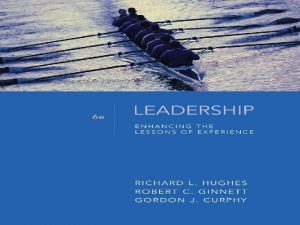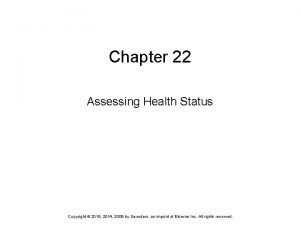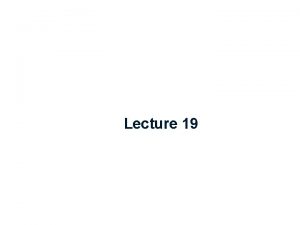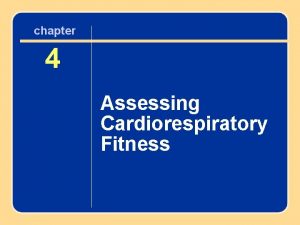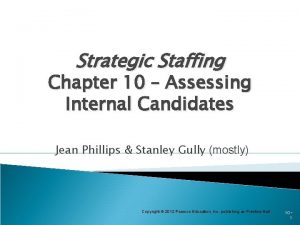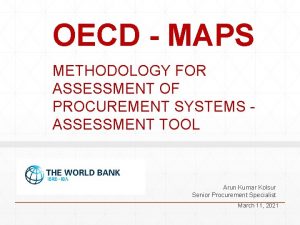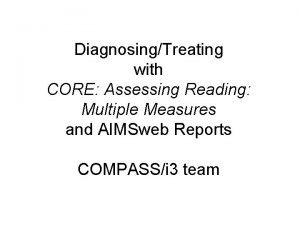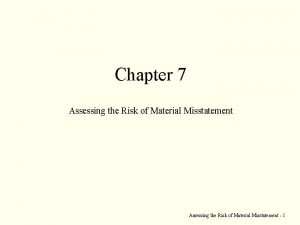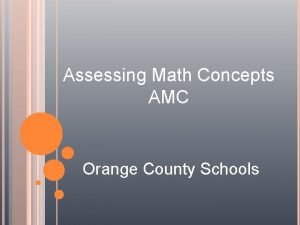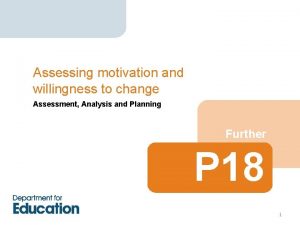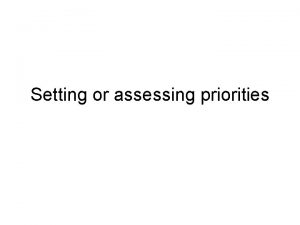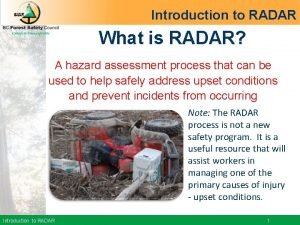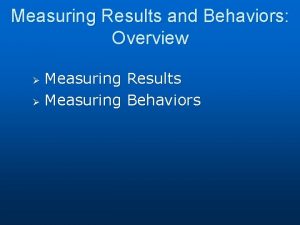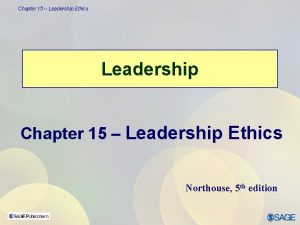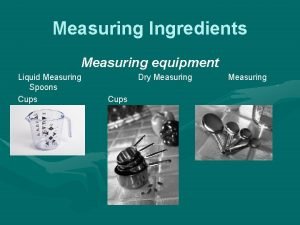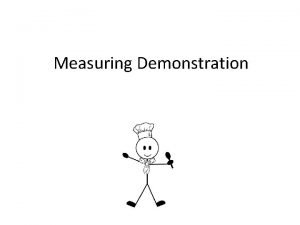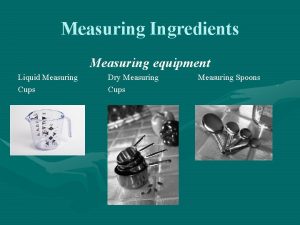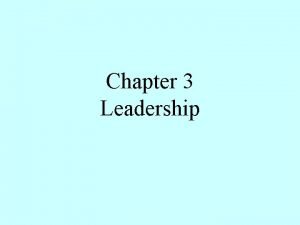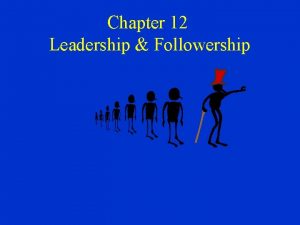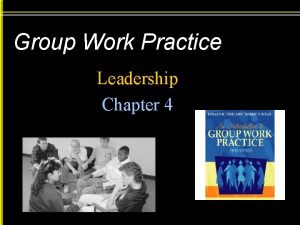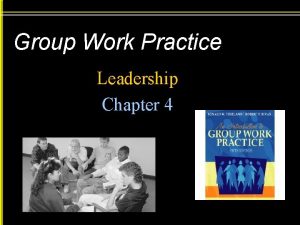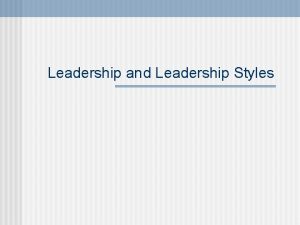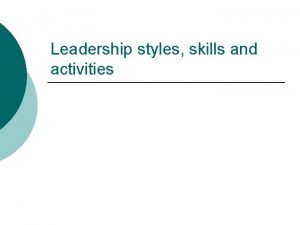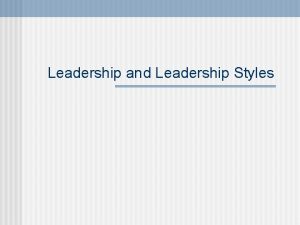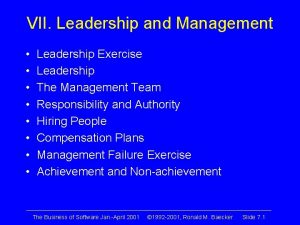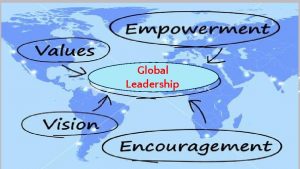4 1 Chapter 4 Assessing Leadership and Measuring

























- Slides: 25

4 -1

Chapter 4 Assessing Leadership and Measuring Its Effects “Only 8% of Fortune 1000 executive directors rate their leadership capacity as excellent, while 47% rated their leadership capacity as fair to poor. ” ~The Conference Board Mc. Graw-Hill/Irwin copyright © 2009 by The Mc. Graw-Hill Companies, inc. All Rights Reserved 1 -2

Practice-Research Gap • The gap between what researchers know about predicting and evaluating leadership effectiveness and the techniques actually used by organizations to hire, evaluate, and promote leaders. • This gap has a profound impact on the quality of people in leadership positions today. 4 -3

Managerial Incompetence • Despite the pervasiveness of leadership, the base rate of managerial incompetence may be somewhere between 50 – 75 percent. • The Dr Gordy test is one way to determine the level of incompetence among leaders. • Effective leaders are individuals who are good at building teams and getting results. • Most people in leadership positions get paid to get results, and they get results by building teams. 4 -4

Managerial Incompetence (continued) • Managers can be categorized as being: – – Competent Managers Results Only Managers Cheerleaders In Name Only Managers • Research shows that organizations having higher number of Competent Managers occupying critical positions are more successful than those without. 4 -5

The Two Dimensions of Managerial Incompetence 4 -6

Need for Leadership Talent Management • The biggest source of worry for organizations anywhere is the lack of high quality leadership talent. • Three critical ingredients most looked for in persons in positions of authority include: – Problem solving and sound decision making abilities. – Local/functional know-how. – Ability to get things done through others. 4 -7

Need for Leadership Talent Management (continued) • Several factors contribute to the shortfall in managerial incompetence: – Demographics – Lack of employee loyalty – Lack of good systems to identify and develop leadership talent – Technology 4 -8

Leadership Talent Management • Leadership talent management system: Consists of those processes and procedures organizations use to hire, develop, evaluate, reward, promote, and retain its leaders. • Research has shown that good talent management systems can have a profound impact on organizational effectiveness and success. 4 -9

Steps Involved in Leadership Talent Management (continued) • Clarify the organization’s strategy for the future. • Identify what are or will be the critical leadership positions in the organization. • Develop a competency model for the critical leadership positions. • Ensure the organization’s recruiting and selection processes are identifying, hiring, developing, rewarding, and promoting the right candidates. • Adopt valid and well-researched processes for hiring, developing, and promoting leadership talent. 4 -10

Assessing Leadership Potential • It is fundamentally concerned with predicting who will or will not be an effective leader before they have been placed into a position. – Accurately predicting managerial effectiveness is critically important but not at all straightforward. • Research has systematically determined which leadership assessment techniques yield more valid and accurate predictions than other techniques. 4 -11

Typical Correlations between Different Assessment Techniques and Job Performance in the United States 4 -12

Best Practices in Assessing Leadership Potential • Research shows that by developing a competency model, one can clearly define the skills and attributes required in the right candidate. • The best candidate would be the person with the most, if not all, of those skills and attributes. • The multiple hurdles approach is the most cost-effective and valid way to identify the best candidate from the applicant pool. 4 -13

Example of a mid-level leadership competency model 4 -14

Multiple Hurdles Approach 4 -15

Multiple Hurdles Approach (continued) • Use most inexpensive assessment techniques first. • Use Internet or paper-and-pencil measures of leadership potential. • Interview the remaining talent pool. – Structured interviews – Unstructured interviews • Put the top three candidates through an assessment center. – In-Basket exercises – Role plays 4 -16

Making Sense of the Process • Many times, having a clearly defined competency model, a biographical form, and structural interview questions linked to the model will suffice. • Research is the only way to determine which assessment techniques are the most valid for which leadership positions. 4 -17

Measuring the Effects of Leadership • Just as various techniques are used to assess leaders, there also various ways to measure their effects on subordinates and organizations. – When judging, the consequences of leader behaviors are examined, than the behaviors per se. • Commonly used measures to judge successful and unsuccessful leaders include: – Superiors’ effectiveness and performance ratings – Subordinates’ ratings of their job satisfaction and morale or of their leader’s effectiveness – Unit performance indices 4 -18

Common Measures of Successful and Unsuccessful Leadership 4 -19

Best Practices in Measuring Leadership Success • Ratings by superiors and subordinates generally yield useful information about a leader’s effectiveness. • Multiple measures often yield the best information about leadership success. • Practitioners need to think critically about how their behavior affects the measures used to judge leadership success. • Practitioners need to be aware of leadership success measures being biased. 4 -20

Methodologies Used to Study Leadership • Qualitative Approach – Case study: In-depth analysis of a leader’s activities. • Quantitative Approaches – Correlational studies: Used to determine statistical relationship between leader qualities and various measures of leadership effectiveness. • Correlation coefficient • Casual inferences – Experiments: Generally consist of both: • Independent variables • Dependent variables 4 -21

Some Common and Uncommon Variations of Leadership Studies 4 -22

Maxims and Theories of Leadership • Maxims: Personal opinions that can give leaders valuable advice about leadership. • Theory: Framework for conceptualizing relationships between variables and guiding research toward a fuller understanding of phenomena. • Theories are central to scientific research because: – Public predictions of how leadership variables are interrelated. – The systematic gathering and analysis of data. – Peer review of results. 4 -23

Jack Welch’s Eight Rules 4 -24

Summary • Leadership is the most important topic in the world today. • Leadership talent management systems helps organizations minimize crisis of insufficient effective leaders. • Various techniques exist for organizations to assess leadership potential and performance. • Quantitative and qualitative approaches are used to study linkages between leadership potential and performance measures. • Maxims may represent valid advice, but they are ultimately no more than personal opinion. • Theories are a collection of testable predictions about the relationships between certain variables. 4 -25
 Assessing leadership and measuring its effects
Assessing leadership and measuring its effects Chapter 4 cultural dynamics in assessing global markets
Chapter 4 cultural dynamics in assessing global markets Assessing health status chapter 22
Assessing health status chapter 22 Transactional leadership vs transformational leadership
Transactional leadership vs transformational leadership Teaching and assessing grammar in the writing classroom
Teaching and assessing grammar in the writing classroom Ppst domain 4 curriculum and planning ppt
Ppst domain 4 curriculum and planning ppt Informal assessment
Informal assessment Assessing a new venture's financial strength and viability
Assessing a new venture's financial strength and viability Many new drivers first fender bender is a backing collision
Many new drivers first fender bender is a backing collision Module 4 topic 1 assessing and managing risk
Module 4 topic 1 assessing and managing risk Adaptive leadership style
Adaptive leadership style Adaptive leadership vs situational leadership
Adaptive leadership vs situational leadership Assessing risk in sport
Assessing risk in sport Unit 18 assessing children's development support needs p1
Unit 18 assessing children's development support needs p1 Task analysis in hrd
Task analysis in hrd Manual for assessing safety hardware
Manual for assessing safety hardware Assessing cardiorespiratory fitness
Assessing cardiorespiratory fitness A nine box matrix requires assessing employees on ________.
A nine box matrix requires assessing employees on ________. Oecd maps
Oecd maps Assessing reading multiple measures
Assessing reading multiple measures Ar = ir x cr x dr
Ar = ir x cr x dr Amc orange county
Amc orange county Assessing motivation to change
Assessing motivation to change Assessing opportunity cost involves
Assessing opportunity cost involves Assessing the situation
Assessing the situation Cultural dynamics in assessing global markets
Cultural dynamics in assessing global markets
